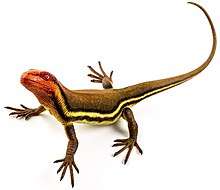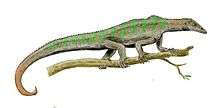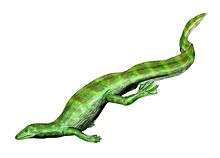Araeoscelidia
Araeoscelidia or Araeoscelida is a clade of extinct diapsid reptiles superficially resembling lizards, extending from the Late Carboniferous to the Early Permian. The group contains the genera Araeoscelis, Petrolacosaurus, the possibly aquatic Spinoaequalis, and less well-known genera such as Kadaliosaurus and Zarcasaurus. This clade is considered to be the sister group to all (currently known) later diapsids.
| Araeoscelidia | |
|---|---|
 | |
| Life restoration of Petrolacosaurus kansensis | |
| Scientific classification | |
| Kingdom: | Animalia |
| Phylum: | Chordata |
| Class: | Reptilia |
| Clade: | Diapsida |
| Order: | †Araeoscelidia Williston, 1913 |
| Subgroups | |
Description
Araeoscelidians were small animals (less than one meter in length) looking somewhat like lizards, though they are only distantly related to true lizards. They differ from other, earlier sauropsids by their slender limbs, their elongated tail, and of course by the presence of two temporal openings, the feature defining the diapsid condition. In Araeoscelis, only the upper temporal opening remains, thus resulting in a derived euryapsid condition.
Genera
Araeoscelidia includes well-known genera such as Araeoscelis (Williston 1910; Vaughn 1955; Reisz, Berman & Scott 1984), Petrolacosaurus (Lane 1945; Peabody 1952; Reisz 1981) and Spinoaequalis (deBraga & Reisz 1995; deBraga & Rieppel 1997), known from virtually complete skeletons. Zarcasaurus (Brinkman, Berman & Ebert 1984), Aphelosaurus (Gervais 1859; Thévenin 1910; Falconnet & Steyer 2007) and Kadaliosaurus (Credner 1889) belong to this clade, but are known only from post-cranial remains and a mandible fragment for Zarcasaurus.
The genus Dictybolos has been included in Araeoscelidia by Olson (1970), but this inclusion has been criticized e.g. by Evans (1988), especially since Olson also included distantly related groups such as protorosaurs and mesosaurs.
New specimens have been discovered in Oklahoma, United States (May & Hall 2002; Swanson & Carlson 2002) but so far lack a scientific description.
Phylogeny
| Diapsida |
| |||||||||||||||||||||||||||||||||||||||
Phylogenetic relationships after deBraga & Reisz (1995) and Falconnet & Steyer (2007).
Stratigraphic and geographic distribution
Araeoscelidia are known from the Late Carboniferous in the United States (Petrolacosaurus, Spinoaequalis) to the Early Permian in France (Aphelosaurus), Germany (Kadaliosaurus) and the United States (Dictybolos, Zarcasaurus, Araeoscelis). Apart from araeoscelidans, only one other diapsid is known before the Late Permian: Orovenator from the Early Permian of Oklahoma (Reisz et al. 2011).
References
Further reading
- Carroll, Robert L. (1988). Vertebrate Paleontology and Evolution. New York: W.H. Freeman and Co. ISBN 0-7167-1822-7.
- Benton, Michael J. (2000). Vertebrate Paleontology (2nd ed.). Oxford: Blackwell Science. ISBN 0-632-05614-2.
- deBraga, M. & Reisz, R. R. (1995). "A new diapsid reptile from the uppermost Carboniferous (Stephanian) of Kansas". Palaeontology. 38: 199–212.CS1 maint: ref=harv (link)
- deBraga, M. & Rieppel, O. (1997). "Reptile phylogeny and the interrelationships of turtles". Zoological Journal of the Linnean Society. 120 (3): 281–354. doi:10.1111/j.1096-3642.1997.tb01280.x.CS1 maint: ref=harv (link)
- Brinkman, D. B.; Berman, D. S. & Eberth, D. Z. (1984). "A new araeoscelid reptile, Zarcasaurus tandyderus, from the Culter Formation, (Lower Permian) of north-central New Mexico". New Mexico Geology. 6 (2): 34–39.CS1 maint: ref=harv (link)
- Credner, H. (1889). "Die Stegocephalen und Saurier aus dem Rothliegenden des Plauen'schen Grundes bei Dresden. 8 – Kadaliosaurus priscus Cred". Zeitschrift der Deutschen Geologischen Gesellschaft. 41: 319–342.CS1 maint: ref=harv (link)
- Evans, S. E. (1988). "The early history and relationships of the Diapsida". In Benton, M. J. (ed.). The phylogeny and classification of the tetrapods. Volume 1: Amphibians, Reptiles, Birds. Systematics Association Special Volume 35 A. Oxford: Clarendon Press. pp. 221–260. ISBN 0-19-857705-2.CS1 maint: ref=harv (link)
- Falconnet, J. & Steyer, J.-S. (2007). "Revision, osteology and locomotion of Aphelosaurus, an enigmatic reptile from the Lower Permian of France". Journal of Morphology (abstract of the 8th International Congress of Vertebrate Morphology, Paris, July 2007): 38.CS1 maint: ref=harv (link)
- Gervais, P. (1859). Zoologie et paléontologie française (2nd ed.). Paris: Bertrand.CS1 maint: ref=harv (link)
- Laurin, M. (1991). "The osteology of a Lower Permian eosuchian from Texas and a review of a diapsid phylogeny". Zoological Journal of the Linnean Society. 101: 59–95. doi:10.1111/j.1096-3642.1991.tb00886.x.CS1 maint: ref=harv (link)
- May, W. J. & Hall, J. D. (2002). "Geology and vertebrate fauna of a new site in the Wellington Formation (Lower Permian) of Northern Oklahoma". Oklahoma Geology Notes. 62 (2): 63–66.CS1 maint: ref=harv (link)
- Olson, E. C. (1970). "New and little known genera and species of vertebrates from the Lower Permian of Oklahoma". Fieldiana: Geology. 18: 359–434.CS1 maint: ref=harv (link)
- Peabody, F. E. (1952). "Petrolacosaurus kansensis Lane, a Pennsylvanian reptile from Kansas". University of Kansas Paleontological Contribution. 10: 1–41.CS1 maint: ref=harv (link)
- Reisz, R. R. (1981). "A diapsid reptile from the Pennsylvanian of Kansas". Special Publication of the Museum of Natural History, University of Kansas. 7: 1–74.CS1 maint: ref=harv (link)
- Reisz, R. R.; Berman, D. S. & Scott, D. (1984). "The anatomy and relationships of the Lower Permian reptile Araeoscelis". Journal of Vertebrate Paleontology. 4 (1): 57–67. doi:10.1080/02724634.1984.10011986.CS1 maint: ref=harv (link)
- Swanson, B. A. & Carlson, K. J. (2002). "Walk, Wade, or Swim? Vertebrate Traces on an Early Permian Lakeshore". Palaios. 17 (2): 123–133. doi:10.1669/0883-1351(2002)017<0123:WWOSVT>2.0.CO;2.CS1 maint: ref=harv (link)
- Thévenin, A. (1910). "Les plus anciens quadrupèdes de France". Annales de Paléontologie. 5: 1–65.CS1 maint: ref=harv (link)
- Vaughn, P. P. (1955). "The Permian reptile Araeoscelis restudied". Bulletin of the Harvard Museum of Comparative Zoology. 113: 305–467.CS1 maint: ref=harv (link)



